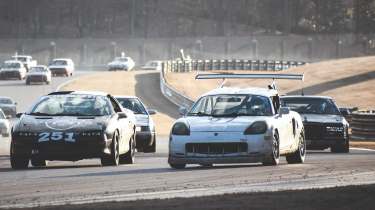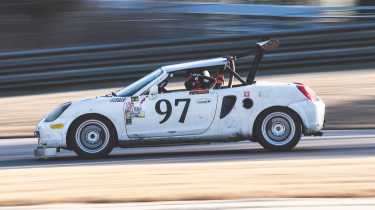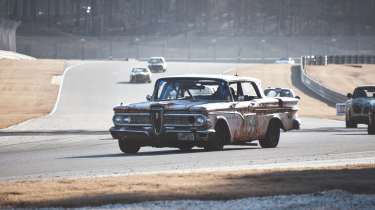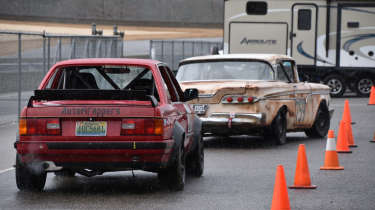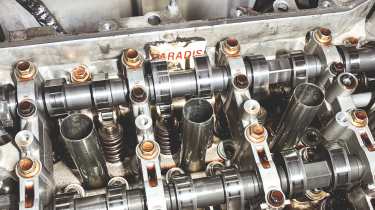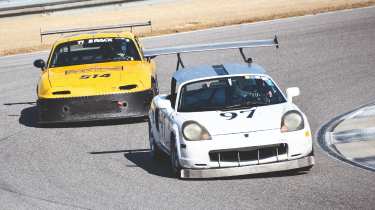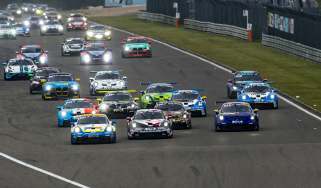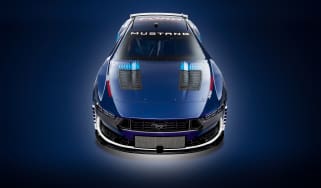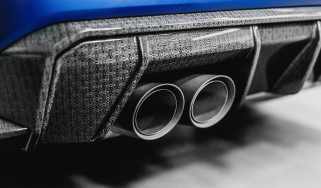24 Hours of Lemons – we dive into the endurance race for $500 scrappers
$500 wouldn't buy you a door mirror for a Le Mans car. At the 24 Hours of Lemons, it's the budget for your entire race car. We get stuck in
The corner falls away in a cascading corkscrew; tyres go light, revs flare. Barber Motorsports Park is a rollercoaster. It’s Day Two of a sports car enduro at the undulating IndyCar-grade circuit running through Alabama woodland. I’m driving a Toyota, its mid-mounted engine singing at high revs, locked in a skirmish with a Porsche. I tuck into its slipstream as it slices past a backmarker.
Toyota versus Porsche. It’s a classic endurance racing battle. Except that the Porsche is a 924 with a giant model fish attached to the roof. And the Mk3 Toyota MR2 I’m driving is currently running on 15 valves, with a piece of licence plate patching a hole in its engine. That backmarker is a Ford Edsel, flanked by a pickup truck, and we’re among more than 100 cars out on the circuit. Welcome to 24 Hours of Lemons.
To backtrack a little, 24 Hours of Lemons is a part endurance race, part carnival formula for budget car racing in the US. Originally the brainchild of car journalist Jay Lamm, it’s been going for nearly 20 years under the tagline ‘Racing for real people’ (and the secondary tagline ‘Racing’s not just for rich idiots. Racing’s for all idiots’).
In essence, it’s a series of two-day races for cars bought and race-prepped for $500 or less. Budget for safety equipment is unrestricted, and all cars and drivers need the same protective kit as for any form of circuit racing – roll-cage, fire extinguisher, safety seat, HANS devices and so on – but the general idea is that teams aren’t meant to spend a ton of money making the car faster. And, to meet the true spirit of the formula, the original car should be a bit rubbish. A lemon, in other words.
I’d heard about Lemons but knew little about it in detail. Then, at the 2024 Indy 500 for evo 324, I was introduced to Bill Dummett. Bill works at a company that sponsors the McLaren IndyCar team but spends some of his spare time racing in Lemons with the Frankenstein Motorworks team. He showed me pictures of their car: a white MR2 with a gigantic elevated wing, wider than the car’s body (selected, in engineer Marc Labranche’s words, ‘for comedic effect’). ‘It’s a lot of fun, and it’s all about not taking things too seriously,’ said Bill, ‘although when everyone’s out on track, sometimes that changes… Come and join us for a race. It would be great to have you.’
I assumed he was just being polite, but when the 2025 Lemons schedule was published, Bill got in touch. ‘We’re planning to do three races; if you were going to choose one, I’d say Barber’s the most fun track.’ In a you-only-live-once frame of mind, I booked some holiday and a flight to Birmingham, AL.
Friday 31 January, 08.00 local time
I meet the friendly Frankensteiners in the Barber paddock with their bewinged MR2 nicknamed Tonya. Its original 1.8-litre 138bhp engine has been swapped for a 2.5 from the Toyota Camry Hybrid, making around double the power. Marc has also fitted some of his own self-machined engine components: his Frankenstein Motorworks outfit has become a full-time, one-man endeavour, engineering new parts and upgrades for MR2s of all generations and endurance-testing them in Lemons races.
If this all sounds like Tonya’s had more than $500 worth of input over her multiple years of Lemons racing, you’d be right, but the formula nowadays has a little leeway from its budget limit if a car meets the intention of the regulations and its team gets into the spirit of things. Marc, a long-time Lemons entrant, once built a Mk2 Toyota MR2 powered by a radial aircraft engine, which has gone down in Lemons folklore (it’s worth Googling). While Frankenstein have led Lemons races outright before, the MR2’s compact fuel tank means extra pit-stops rule them out of likelihood for victory. Not that we won’t try.
Friday, 10.00
Together with Marc, Bill and teammates Alex and Mike, I’ll be one of five drivers in the car this weekend. Friday is practice day and my first chance to experience both Barber and the car. And being in the midst of the most varied pack of cars I’ve ever shared a track with. As I trundle through the paddock towards the pitlane, more and more competitors are beginning to arrive. Some are cars that, condition aside, would ordinarily be desirable: E30 3-series, Honda Integras, Subaru Imprezas, a few Porsches.
Others are barely recognisable under scars and dents from years of racing, or a rash of surface rust. There’s a Jeep of some kind, a replica ’70s police car, various Mazda Miatas (one running a Plymouth V8), a swarm of modern-era Beetles and all manner of other wheeled creations, mostly bedecked in weird and wonderful liveries (some including model fish). There’s not much that hasn’t found its way into a Lemons race at some point over the years: hearses, food trucks, even a Rolls-Royce.
It’s steadily raining, so aside from being a bit of a rollercoaster, Barber currently also resembles a toboggan run in terms of grip. On old tyres for practice and heavily cambered suspension set up for the dry, the Toyota is a tad nervous. My worst nightmare is putting it in the wall before the race has even started, so I tip-toe around, getting to grips (or as much grip as I can find) with circuit, car and competitors. Everyone else is being similarly cautious.
Other drivers’ awareness is very good; everyone’s looking out for each other and giving themselves space. Impressive given that you don’t actually need a race licence to compete in Lemons: just a road licence, making it one of the most accessible forms of circuit racing possible.
That Edsel, by the way, is pretty damn quick. So is the aforementioned pickup, one of several on the entry list. Back in the paddock, more teams are still arriving. Not all will practise today. I naively ask the Frankenstein team when qualifying is. They laugh. There isn’t any. After practice today, the race begins first thing tomorrow. Some drivers won’t even turn a wheel before they’re in the race. That blows my mind slightly.
Lemons events are held all over the US. This particular race is the ’Shine County Classic (’Shine as in moonshine; other location-themed Lemons event names include Sears Pointless, Cain’t Git Bayou, Pacific Northworst… you get the idea). While there are a few ‘True 24’ round-the-clock races in the calendar, the majority of events are – like this one – 14-hour races split into two halves over a Saturday and Sunday with an overnight break in between.
Friday, 17.00
Tech inspection for cars and drivers’ racewear alike takes place through the afternoon. For all the light-hearted atmosphere and janky-looking cars, Lemons is rightly deadly serious on safety gear and my racing kit goes through one of the most thorough inspections it’s ever had. The car gets a thorough going over too.
Not only for safety: there’s also a ‘bullshit’ inspection, with penalties applied for teams that have flagrantly overspent or whose car is overqualified to claim ‘lemon’ status. (Hence a conspicuously nice Nissan 350Z that’s already prepped for another form of racing attracts a penalty of over 300 laps.) Lemons judges also decide which class your car sits in: Class C for the slowest, most mechanically sickly entries; A for the quickest cars; and B for those in between. We’re in Class A.
Meanwhile, a team racing a ’90s Jag XJR ‘reveal’ it at tech-inspection in a pitch-perfect parody of JaGuar’s rebrand, with team members posing as paintbrush-clutching models pulling the covers from the car.
Saturday 1 February, 09.00
No rain for Day One of racing, under Alabama skies as blue as the Lynyrd Skynyrd song proclaims. Alex is belted in to start the race. There’s no formal grid: cars are lined up in the paddock in first-come-first-served-rows, then waved onto the track to turn warm-up laps. Once everyone’s out there and warmed up, the green flag is dropped. Whoever happens to cross the line first after it’s waved is the de facto leader. The first seven hours of racing starts now.
The pot-luck starting order puts Alex somewhere in the middle of the pack but he makes rapid progress, passing car after car. And then. He radios to say there’s smoke from the engine. Marc calmly calls him into the pits and a few moments later a sickly Tonya is up on axle stands. A rocker has made a bid for freedom, punching a hole in the side of the cylinder head. (Marc later traces the cause to an undersize replacement valve fitted during the build process.)
> How to win the Le Mans 24 Hours: we consult 2024’s winners
That’s where the ingenious licence plate fix comes in. Marc procures a metal numberplate (from Louisiana Sportsman’s Paradise), produces a pair of tin-snips and cuts a metallic sticking plaster (neatly including the word ‘Paradise’), which he bonds over the hole with J-B Weld epoxy resin.
Mike’s due in next but kindly suggests that, since I’ve travelled furthest, I go ahead of him, in case the repair doesn’t hold. So, for the first time, I begin a racing stint on axle stands, getting belted in while the car’s put back together. Marc asks me to hold the engine at 7000rpm: it sounds sweet (even now on 15 valves) and the repair seems to be holding so… let’s go.
Moments later I’m joining a Lemons race for the first time. Out of the pits, into the Big Dipper that is turns Two and Three, over the blind, flat-out crest of Turn Four and… hard on the brakes for near-stationary cars. There’s a yellow flag ahead and a concertina traffic jam. Accidents may be few and far between but broken-down cars are commonplace and need to be towed back to the pits.
So every now and then you’re sharing the track with a tow-truck recovering a stranded competitor. It’s a bit like the Nürburgring 24 Hours, albeit at slightly lower speeds but similar intensity. No two laps are the same; with so many cars on track, you’re taking different lines through every corner, cutting through traffic cleanly without taking risks, yet also without losing time. You can’t relax for a moment.
Now, on a dry track and newer tyres, the MR2 is flying. Marc has built a fabulous racing car. Lateral grip is enormous and though it has the pointiness and instant yaw off-throttle that marks out a mid-engined car, it’s no longer nervous like it was in the wet. It’s neutral in balance and rapid in pace.
Bill and Mike round out the day’s racing. We’re running in seventy-somethingth place after the lost repair time but we’re one of the quickest cars out there. At the front, the Lemonaid team’s BMW E46 3-series is motoring too, five laps ahead of second place (another 3-series). The frontrunning teams are trying their utmost to win, but it’s not the be-all and end-all. ‘The organisers don’t make a big deal of the winner,’ Bill explains. ‘There’s prize money of $500 but they tend to pay it in the most inconvenient form possible, like a bag of nickels.’
Core to the spirit of the event is the engineering challenge in keeping these cars – many of which would ordinarily have been scrapped or cannibalised for parts long ago – lapping to the end of the 14 hours, all under the stress of racing speeds that put far more load through a road car than its designers intended. It’s not long before the paddock’s populated with various poorly cars being inventively remedied.
The chequered flag falls on the first half, followed by nightfall upon the circuit, and repairs are in full swing up and down the paddock. Our car gets a wheel bearing change; the team opposite us cheerily lend us some tools as their own repairs continue. Everyone helps everyone out here.
Sunday 2 February, 10.30
Marc is flying. He’s taken race start of Day Two and is one of the fastest on track. And then. He radios to report a loss of voltage, suspecting the alternator. A few minutes later Tonya’s back on axle stands. Alex phones a local auto spares centre and reserves a reconditioned Camry alternator. An alternator change would normally be an engine-out job, but by the time Alex is back with the part, Marc’s cut an access panel in the firewall. After a spot of keyhole surgery, the new unit is in, the hole patched up and the car’s back out, now with Alex at the wheel. Since racing stopped to respect church hour (this is Alabama, after all), we’ve lost relatively minimal time.
Sunday, 19.00
The chequered flag falls, and the remaining running cars – an impressive number – peel off the circuit to a standing ovation from teams and spectators. Getting to the finish really is an achievement in itself. I think we finish 58th in the end. Not bad considering we spent a few hours in the pits. In an extra flourish post-race, Frankenstein Motorworks are awarded the much-coveted ‘Heroic Fix’ award for the licence plate patch and alternator swap. We also discover we’ve set the second-fastest lap of the race, on 15 valves.
It’s been a whirlwind introduction to Lemons, a surface-level taste of the culture. Underneath the frivolity there’s real substance: serious feats of engineering and truly tough, skilful racing too. It’s open to anyone, novices are made welcome and encouraged, and the seat-time-to-spend ratio is almost unrivalled for full-blown car racing. Oh, and who won? I’ve no idea to be honest. Which sums up the Lemons spirit about as well as I ever could.
